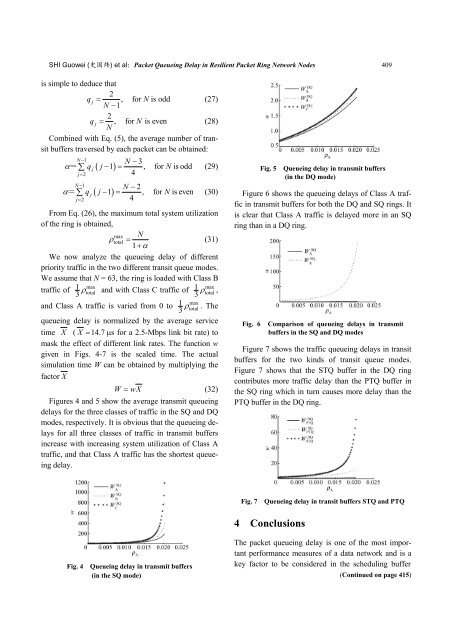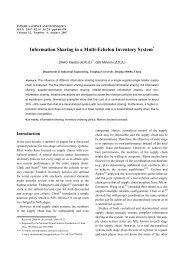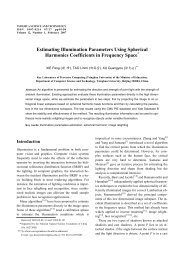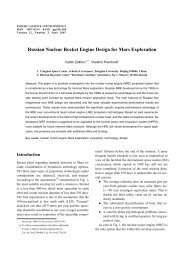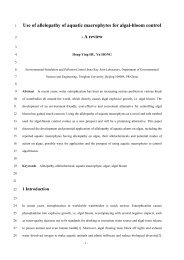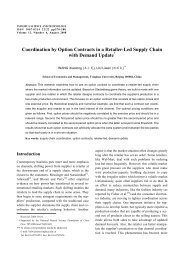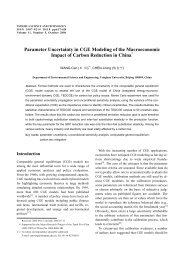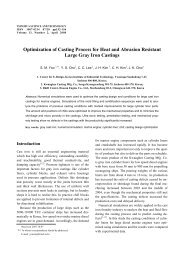Packet Queueing Delay in Resilient Packet Ring Network Nodes
Packet Queueing Delay in Resilient Packet Ring Network Nodes
Packet Queueing Delay in Resilient Packet Ring Network Nodes
You also want an ePaper? Increase the reach of your titles
YUMPU automatically turns print PDFs into web optimized ePapers that Google loves.
SHI Guowei (史国炜) et al:<strong>Packet</strong> <strong>Queue<strong>in</strong>g</strong> <strong>Delay</strong> <strong>in</strong> <strong>Resilient</strong> <strong>Packet</strong> R<strong>in</strong>g <strong>Network</strong> <strong>Nodes</strong> 409<br />
is simple to deduce that<br />
2<br />
q j = ,<br />
N − 1<br />
for N is odd (27)<br />
2<br />
qj= ,<br />
N<br />
for N is even (28)<br />
Comb<strong>in</strong>ed with Eq. (5), the average number of transit<br />
buffers traversed by each packet can be obta<strong>in</strong>ed:<br />
N −1<br />
N − 3<br />
α=<br />
∑ qj( j− 1 ) = , for N is odd (29)<br />
4<br />
j=<br />
2<br />
N −1<br />
N − 2<br />
α=<br />
∑ qj( j− 1 ) = , for N is even (30)<br />
4<br />
j=<br />
2<br />
From Eq. (26), the maximum total system utilization<br />
of the r<strong>in</strong>g is obta<strong>in</strong>ed,<br />
max N<br />
ρtotal<br />
= (31)<br />
1+<br />
α<br />
We now analyze the queue<strong>in</strong>g delay of different<br />
priority traffic <strong>in</strong> the two different transit queue modes.<br />
We assume that N = 63, the r<strong>in</strong>g is loaded with Class B<br />
traffic of 1 ρ and with Class C traffic of 1 ρ ,<br />
3 3<br />
max<br />
total<br />
and Class A traffic is varied from 0 to<br />
max<br />
total<br />
1 max<br />
ρ<br />
3 total . The<br />
queue<strong>in</strong>g delay is normalized by the average service<br />
time X ( X = 14.7 µs for a 2.5-Mbps l<strong>in</strong>k bit rate) to<br />
mask the effect of different l<strong>in</strong>k rates. The function w<br />
given <strong>in</strong> Figs. 4-7 is the scaled time. The actual<br />
simulation time W can be obta<strong>in</strong>ed by multiply<strong>in</strong>g the<br />
factor X<br />
W = wX<br />
(32)<br />
Figures 4 and 5 show the average transmit queue<strong>in</strong>g<br />
delays for the three classes of traffic <strong>in</strong> the SQ and DQ<br />
modes, respectively. It is obvious that the queue<strong>in</strong>g delays<br />
for all three classes of traffic <strong>in</strong> transmit buffers<br />
<strong>in</strong>crease with <strong>in</strong>creas<strong>in</strong>g system utilization of Class A<br />
traffic, and that Class A traffic has the shortest queue<strong>in</strong>g<br />
delay.<br />
Fig. 4 <strong>Queue<strong>in</strong>g</strong> delay <strong>in</strong> transmit buffers<br />
(<strong>in</strong> the SQ mode)<br />
Fig. 5 <strong>Queue<strong>in</strong>g</strong> delay <strong>in</strong> transmit buffers<br />
(<strong>in</strong> the DQ mode)<br />
Figure 6 shows the queue<strong>in</strong>g delays of Class A traffic<br />
<strong>in</strong> transmit buffers for both the DQ and SQ r<strong>in</strong>gs. It<br />
is clear that Class A traffic is delayed more <strong>in</strong> an SQ<br />
r<strong>in</strong>g than <strong>in</strong> a DQ r<strong>in</strong>g.<br />
Fig. 6 Comparison of queue<strong>in</strong>g delays <strong>in</strong> transmit<br />
buffers <strong>in</strong> the SQ and DQ modes<br />
Figure 7 shows the traffic queue<strong>in</strong>g delays <strong>in</strong> transit<br />
buffers for the two k<strong>in</strong>ds of transit queue modes.<br />
Figure 7 shows that the STQ buffer <strong>in</strong> the DQ r<strong>in</strong>g<br />
contributes more traffic delay than the PTQ buffer <strong>in</strong><br />
the SQ r<strong>in</strong>g which <strong>in</strong> turn causes more delay than the<br />
PTQ buffer <strong>in</strong> the DQ r<strong>in</strong>g.<br />
Fig. 7 <strong>Queue<strong>in</strong>g</strong> delay <strong>in</strong> transit buffers STQ and PTQ<br />
4 Conclusions<br />
The packet queue<strong>in</strong>g delay is one of the most important<br />
performance measures of a data network and is a<br />
key factor to be considered <strong>in</strong> the schedul<strong>in</strong>g buffer<br />
(Cont<strong>in</strong>ued on page 415)


